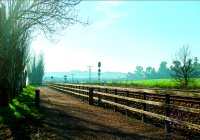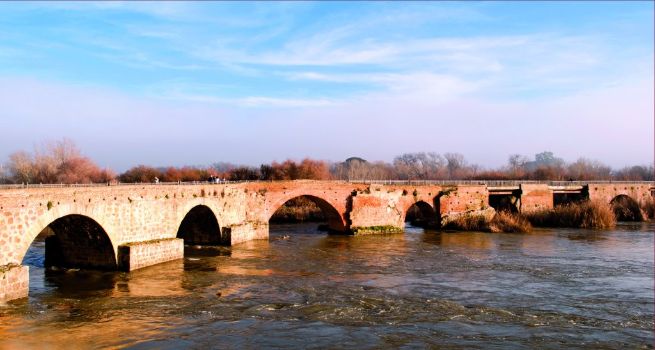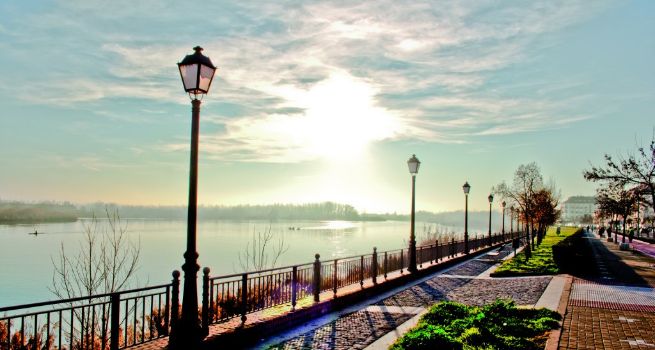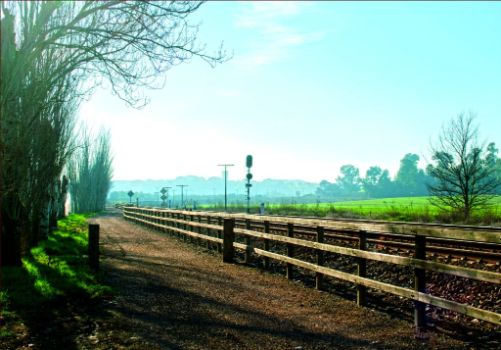Net of Natural
Trails

Stage 26: Talavera de la Reina - Calera y Chozas
Description
The Tagus through large crop plains
The Nature Trail leaves the "City of Ceramics", venturing into vast irrigated fields where one can see close-up the canals that distribute water to these lands.

The Stage begins near Talavera de la Reina's Roman bridge over the Tagus. From here, the route continues along the promenade that runs parallel to the river, with rest areas and abundant shade. The banks of the Tagus in Talavera burst with life and activity. The river is used and enjoyed by different groups: people taking a stroll along its banks, bikers, anglers, kayakers and, occasionally, swimmers.
The Trail gradually drifts away from the urban environment to escort the river. At the edge of Talavera's riverside walk, there is a sign showing all the towns that lie along this Stage. The route will travel along a wide track with some motorised traffic; therefore, caution should be exercised. Talavera's power plant is located soon after setting out on this track.

Livestock farms and large-scale croplands, as well as the canals that water these fields, begin to appear on both sides of the Trail. There are many perfectly signposted crossroads, leaving no room for doubt as to the direction to be followed.
Large, green fields stretch as far as the eye can see, with the view limited only by the Gredos mountain range on the horizon. The route crosses several water distribution systems: small irrigation ditches as well as large canals that channel large amounts of water to the edges of these meadows. The Trail is also intersected by creeks, including the Bárrago.

The route passes next to interesting places like the huge nursery with many hardwood and conifer species. The water is supplied to the farm via a canal from the river.
About nine kilometres from Talavera de la Reina, there is a wide and easy side road leading directly to the town of Alberche. To take this road, one must veer right to the northwest. The route enters the town from the south, where an information panel and a rest area are located.
Back on the Trail, which continues southwest, the route heads down long, straight roads that run parallel to the river, surrounded by vast fields where corn dominates. Canals and ditches full of water abound throughout this Stage. The water can be used on hot days to refresh oneself.
Sites of interest
Profile

Highlights
Further information
Calera y Chozas
As the name indicates, this town has been closely associated with mining. It was founded in the fifteenth century as a settlement for workers employed at various limestone mines, whose stones were used to build, for examples, the Talavera de la Reina Collegiate Church.
Next to the landscaped square is the Romanesque parish church of San Pedro Apóstol, with a Renaissance façade (16th century) and a triangular pediment topped with balls.
The church was built partly in stone and the rest with bricks and earthen walls. It consists of three naves with several side chapels, one of which is devoted to Nuestra Señora de la Vega, and the other two to the Santísimo Cristo de Chozas and Nuestra Señora de los Dolores.
Calera y Chozas has a long-standing tradition of celebrating different festivities, including Carnival, the pilgrimage of Our Lady of Vega and the local festival in honour of the Cristo de Chozas in September.
Llanuras de Oropesa, Lagartera and Caldera y Chozas SCI and SPA
These sites are located on the flood plains along the right bank of the River Tagus, formed by sandy sedimentary basins and fluvial deposits. The area is covered by large annual xerophyte grasslands with a rich diversity of steppe birds, including Montague's Harrier (Circus pygargus), Bustard(Otis tarda), Little Bustard (Tetrax tetrax), Black-bellied Sandgrouse(Pterocles orientalis) and Lesser Kestrel (Falco naumanni).
The creeks are home to a variety of riparian formations (ash trees, willows, etc.). Furthermore, amphibian plant species of major interest thrive in the many ponds. There are also a few well-preserved "dehesas" scattered on the rolling hills.





